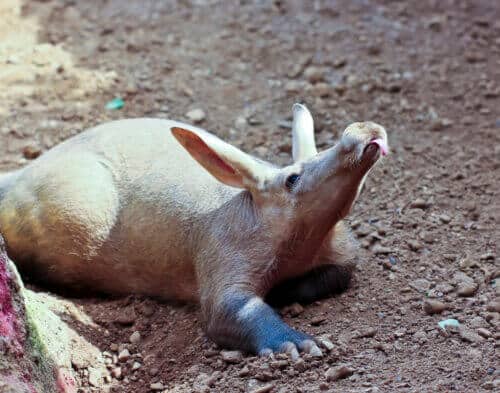Although it is a common animal, it was difficult to see it active during daily trips, since during the day it hides in burrows and only goes out to look for food at night, at least it was until recent years when there are more and more sightings of hardwork activity during the day, mainly in hot and dry areas

I have long written about the cohabitation of bats with different mammals (corona = bats+pangolins). One of the partners is the African anteater also known as the African anteater (Orycteropus afer)
In South Africa its name is "Aardvark" which means "land pig" in Afrikaans, but it is also common to call it an African anteater. It is found in Africa south of the Sahara. It should not be confused with the anteaters on the continents and in other regions, these too got their name because of their specialization in eating ants and termites but there is no genetic connection between them.
Although it is a common animal, it is difficult to see it active during daily trips, since during the day it is hidden in dens and only goes out to look for food at night, at least it was until recent years when there are more and more sightings of hardwork activity during the day, mainly in hot and dry areas.
Daily observations portend a problem, as it is possible that it does not find enough food at night, so according to a study conducted by researchers from the University of the Witwatersrand in South Africa, in order to understand how the hardworks deal with the heat and dryness, the researchers surveyed its population In the hot and dry Kalahari desert.
The researchers worked in the Tswalu Game Reserve and used tiny computers that recorded the animal's body temperature and activity around the clock for three years. Monitoring that made it possible to understand how the hardworks change their behavior relative to the environmental conditions during the seasons.
It was found that during periods of drought, the African anteaters struggled to find enough food and had a hard time maintaining body heat during cold nights, so they moved the activity times to daytime hours. The change was so great that some of the bears did not survive and died of starvation, which harms the entire environment.
The importance of African anteaters to a large and diverse environment. There is no other African mammal that digs so many burrows, which are crazy hiding places from the heat and cold for many other mammals, birds and reptiles which are used to raise offspring.
That's when In the last fifty years the temperatures are rising and the arid areas are growing all over Africa. The warming endangers the hardworks as well as all the animals that use their dens. In previous years, the "bears" were active at night and thus regulate their body temperature between 35 and 37 degrees, but this behavioral pattern changed during periods of drought that were in the Kalahari during the three years of the study, the hardworks were also active during the day and their body temperature dropped to 30 degrees.
By using NASA satellite sensors and local cameras to document the state of the vegetation in the field, as well as the reports of loggers, it turned out that the extreme changes in the behavior and body temperature of the "bears" were directly related to the availability of the grass that serves as food for ants and termites. Less vegetation, less ants and termites, less food available for "bears".
When the food reserves are reduced, the "bears" do not manage to maintain a permanent body beach and are therefore forced to go out to collect food during the day.
Moving the activity to the hot days saves energy to maintain body heat, that in other cases it could be used to look for food, but for the researched even the saving of energy was not enough in times of drought, when the ground is bare and there is a lack of food. As a result, seven of the twelve anteaters studied died. In addition, the bodies of many other anteaters that died of starvation were found.
In the Red List of the International Organization for Conservation of Nature (IUCN), the "bears" are cataloged as Least Concern, that is, not in danger, but the researchers claim that in the dry areas they are in danger. The climate changes that cause the African anteaters to disappear from those habitats may have devastating consequences for many other animals that rely on and depend on the dens of the "bears".
It is appropriate that the research findings raise awareness of the results of warming and be used by reserve managers for policy decisions. There is a need for an assessment of the entire population of African anteaters, as well as the conservation of the species that use their dens in areas where the "bears" are in danger of extinction.
The researchers add that there is a need for a smart use of water bodies and the enlargement and expansion of corridors, which will allow movement between habitats. Of course, there is no doubt about the urgent need to moderate emissions to prevent overheating.
It is clear that in any attempt to solve the plight of the animals due to the warming, it is necessary to understand the ability of the animals to deal with dry conditions, therefore there is a need for an extensive study of the physiology and behavior of species that live in hot and dry areas of the world.
More of the topic in Hayadan:

One response
He has a Hebrew name: Shenbob